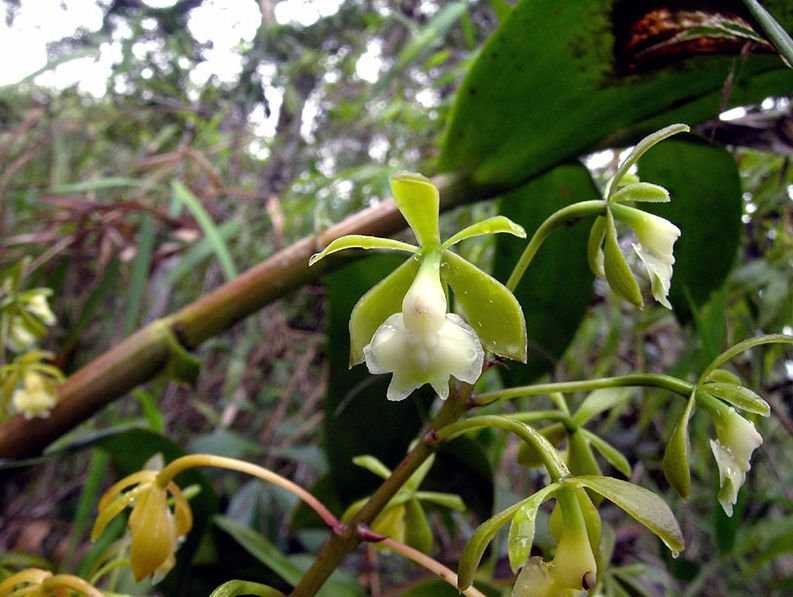

Epidendrum hassleri Cogn. 1909 GROUP Pseudepidendrum SUBGROUP Densiflorum
Photo by © M A Campacci
Drawing by © Jimenez, Hágsater & E.Santiago and The AMO Herbario Website

Common Name Hassler's Epidendrum [Swiss Physician naturalist and botanist well known for his collections and contributions to the flora of Paraguay 1800’s]
Flower Size 1" [2.5 cm]
Found in eastern Paraguay, Rondonia, Goias and Parana states of Brazil and into Missiones province of Argentina in shady humid forests at elevations of 50 to 200 meters as a large sized, hot growing epiphyte with simple, cane-like, terete, base covered by tubular, nonfoliar becoming fibrous with time sheaths, erect stems carrying numerous, distichous, articulate, green, membranaceous, soft, lanceolate or narrowly elliptic, acute, margin entire leaves that blooms in the spring without a spathe, on an erect, flowering only once, racemose to paniculate, arching; peduncle .8 to 1" [2 to 2.5 cm] long , terete, thin, nearly totally hidden by a prominent, triangular-lanceolate bract, 1 t 2.2" [2.5 to 5.5 cm] long, conduplicate, ancipitose, acute; rachis 5.2 to 6.2" [13 to 15.5 cm] long, thin, straight, formed by 6 to 7 densely many-flowered racemes 2.8 to 4.8" [7 to 12 cm] long, each subtended by a prominent basal, triangular, long-acuminate bract, 6 to 7.2" [15 to 18 cm] long overall, simultaneously to 70 flowered inflorescence and much shorter than the ovary, triangular, acuminate floral bracts and carrying resupinate, green, fragrant during daytime flowers with the apex of the column and disc of the lip white to cream-colored, the disc occasionally tinged light purple.
"Epidendrum hassleri belongs to the GROUP Pseudepidendrum which is characterized by caespitose plants, cane-like stems, acute to acuminate leaves, usually apical inflorescence, without any spathaceous bract, though it may have several bracts, the mostly filiform petals and the lip usually 3-lobed with 3 parallel fleshy keels, the apical lobe often bifurcate, the “bird-wing” type pollinia, at least the inner pair, and SUBGROUP Densiflorum where the short-pedunculate inflorescence is paniculate, flowering only once, flowers are green, the apex of the column and disc of the lip creamy-white, the calli sometimes tinged purple, the petals are linear-oblong to linear-oblanceolate, never filiform, and the pollinia unequal in shape, only the inner pair “bird-wing” like. The species is recognized by the robust stems, paniculate inflorescences (the type is only racemose), oblanceolate-elliptic to spatulate-oblanceolate sepals .44 to .56" [11 to 14 mm] long, linear-oblanceolate to linear oblong petals .4 to .52" x .4 to .42" [10 to 13 x 1 to 1.5 mm], the lip wider between the lateral lobes than between the lobes of the mid-lobe directed upwards, and the ovary .6 to 1" [15 to 25 mm] long. Epidendrum brachythyrsus Kraenzl. has thin stems, oblanceolate sepals .48 to .52" [12 to 13 mm' long, petals linear-oblong, and the lip is as wide between the lateral lobes as between the lobes of the mid-lobe, ovary is .8 to 1.32" [20 to 33 mm] long. Epidendrum densiflorum Hook. has dense, many-flowered, paniculate inflorescences, with a slightly 3-lobed, equally wide between the lateral lobes as at the mid-lobe which is very short and forming a pair of obliquely triangular, acute lobes. Epidendrum noackii Cogn. has shorter, thinner stems, ca. 20" [50 cm] tall, narrow leaves, and a short, few-flowered inflorescence, 2.8 to 3.2" [7 to 8 cm] long. Epidendrum andres-johnsonii Hágsater & E.Santiago has thinner stems, ca. .16 to .32" [4 to 8 mm] in diameter, the lip is sub-entire, nearly as wide between the lateral lobes and the mid-lobe, and the mid-lobe is very short and barely formed. Epidendrum lindbergii Rchb.f. belongs to the GROUP Viridipurpureum recognized by the presence of a spathe and wider petals; it has .4" [10 mm] long sepals, wide petals oblanceolate-spatulate, .4 x .12" [10 x 3 mm], an entire lip, reniform with the base deeply cordate, and the apex widely emarginate and a pair of short incisions on the sides so as to suggest an incipient, short mid-lobe." Hagsaer etal 2013
Synonyms
References W3 Tropicos, Kew Monocot list , IPNI ; Icones Orchidacearum 14 Plate 1408 Hagsater & Santiago 2013 See recognition section; Icones Orchidacearum 14 Plate 1413 Hagsater & Santiago 2013 See recognition section; Icones Orchidacearum 14 Plate 1423 Hagsater & Santiago 2013 See recognition section; Icones Orchidacearum 14 plate 1436 Hagsater & Sanchez 2013 Drawing fide; Icones Orchidacearum 14 Plate 1450 Hagsater & Sanchez 2013 see recognition section; Icones Orchidacearum 14 Plate 1462 Hagsater & Sanchez 2013 see recognition section;
--------------------------------------------------------------------------------------------------------------------------
--------------------------------------------------------------------------------